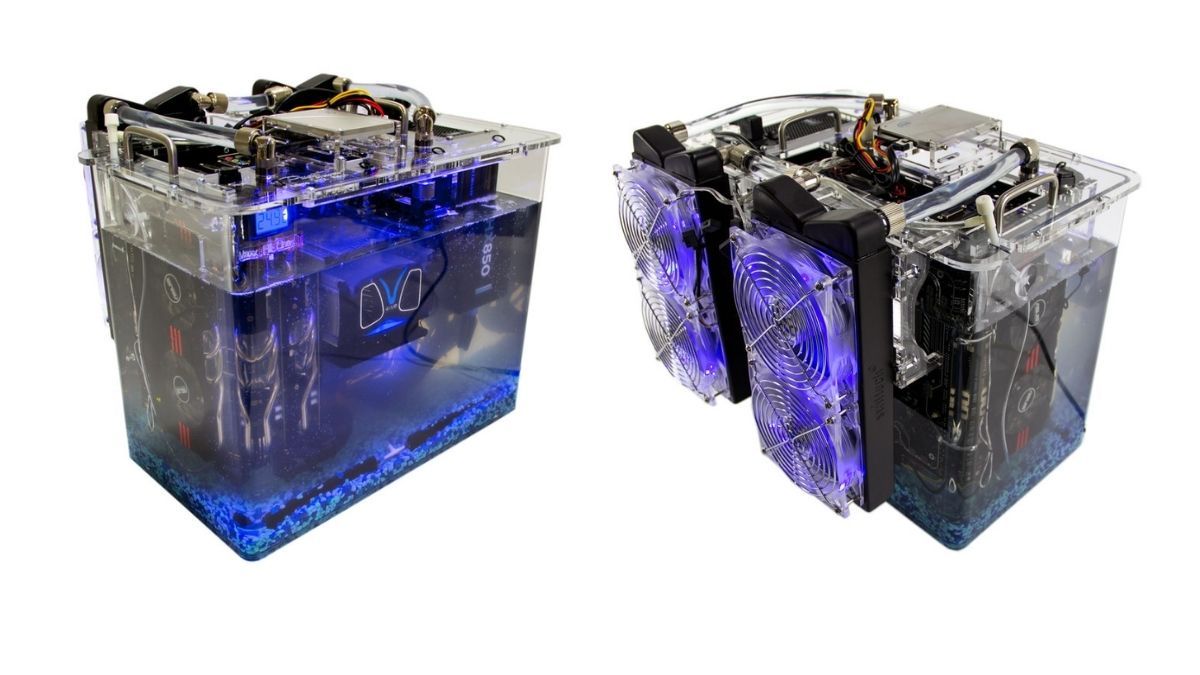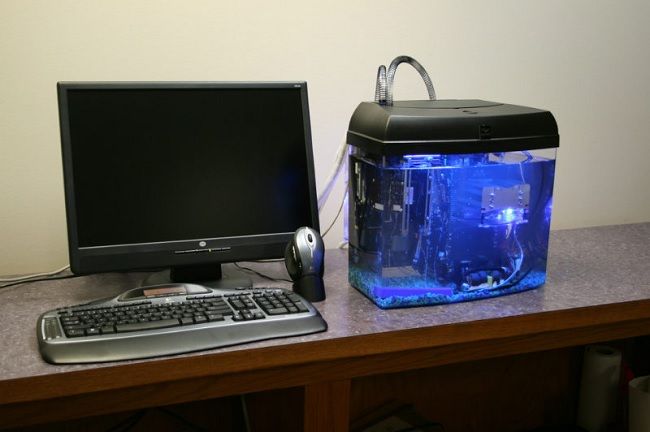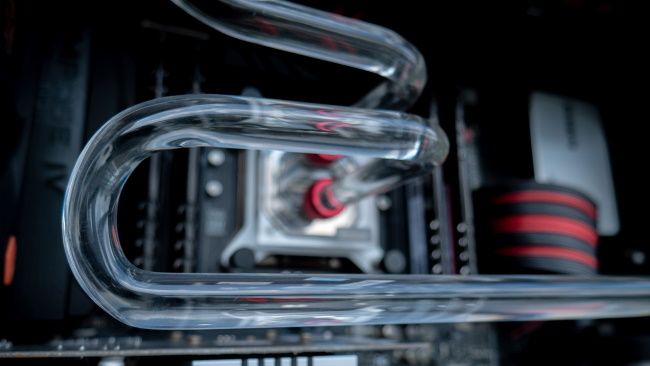Quick Links
At one point, PC performance enthusiasts had the idea to cool a computer by immersing its components in mineral oil---and it worked! Yet today no one's doing it anymore, so what happened to these awesome submerged "fish tank" PCs?
How Does This Even Work?
To make a computer that's cooled by mineral oil, you need a few things on your shopping list:
- A leakproof container, such as an aquarium tank.
- Special non-conductive mineral oil.
- An (optional) pump that circulates oil in the system.
- An (optional) radiator, although you'll want one on a system that's always-on.
All of the solid-state components of the computer are submerged in mineral oil and their heat is dissipated into it directly. Mineral oil has a high specific heat capacity. That's how much energy you need to pump into the oil to raise its temperature by (for argument's sake) one degree.
In practice, this means that you can keep putting heat into the oil and it will slowly heat up until it reaches temperature equilibrium. From that point onward, the system will run at a stable temperature under load. Assuming this temperature is below the maximum end of the range, your cooling worries are over.
Passive oil cooling is practical for people who use their computer for a few hours a day and then switch it off, put it to sleep, or let it idle overnight. The oil cools slowly, ready to absorb more heat the next day.
For systems that need active cooling, you can use a pump that circulates the oil through a radiator. Fans extract heat from the oil running through the radiator cooling the whole thing down. While this isn't as quiet as a passive system, using large low-RPM fans triggered only at certain temperature thresholds is still quite inaudible.
Early Homebrew Experiments
Just as with water cooling, in the beginning, you could not buy the equipment you needed to make a mineral oil system off the shelf. That meant people who wanted to try building such a computer had to make a visit to the local aquarium shop and perhaps repurpose small automotive oil radiators.
You'll still find forum posts all over the internet of these projects. Similarly, some magazine publications and YouTubers tried their hand at building these systems as well, with varying levels of success. Interest in oil-cooled PCs started taking off among performance enthusiasts. "Taking off" might be an overstatement, but it was an intriguing option if you wanted high-performance cooling in a system that could run 24/7.
Commercial Mineral Oil Kits
With enough interest in the enthusiast market, there were actually some commercial mineral oil kits on sale. The best-known of these is the kit from the custom system builder Puget. The company tested and developed several iterations of a mineral oil cooling system, running their first prototype for over a year to see what the long-term effects were. Satisfied that it was feasible, you could (for a while) buy the kit from them.
Sadly, another company claimed that Puget's oil-cooling kit infringed on their patents, and rather than pay royalties, Puget decided to stop selling the kits. It's not clear how many people bought such kits or whether they built long-term systems with them. Either way, we could not find many commercial kits on the web today. One company, Coolbitts, does offer an immersion kit for high-end systems for an eye-watering $2450.
Mineral Oil Cooling Has Problems
Cooling a computer with mineral oil has plenty of advantages and it's an interesting way to create a unique computer that looks awesome. At least, assuming you do it right. That being said, there are many issues you have to deal with when building a mineral oil computer system.
First, the oil itself has to be maintained. Puget systems said in their testing that changing or filtering the oil once a year would probably be sufficient. It's not that the oil gets worse at cooling, it's just that it becomes less clear over time, affecting the look of the computer.
If you have optical drives or mechanical hard drives, they can't be immersed in oil, since they are designed to work in air. This means you have to create a special bay and cabling. These days, with SSDs and digital downloads, you don't need these types of drives in your PC, so it's less of an issue.
Any input/output device, such as USB ports, should preferably be out of the oil. While it won't hurt your ports or your plugs in the short term, having a non-conductive fluid between the two connectors probably isn't a great idea. Oil can also wick up connected cables and slowly end up outside the tank!
There are also stories of mineral oil dissolving rubber components. When Puget tested its system, even after a year, there wasn't any evidence of this. However, it does depend on the exact oil and type of material. This is why it's important to use specific specialist mineral oil and not just the stuff you find in a supermarket.
Ultimately, mineral oil PC cooling has a lot of maintenance issues that make it impractical for mainstream use, which is probably why water cooling has become the preferred way to cool high-performance components.
Water Cooling Takes the Crown
Today it's not hard to water-cool your CPU. You can simply buy a water cooler from a store, attach it to the rails that are probably already in your PC case and stick it on your CPU just as easily as a normal air cooler. GPUs are trickier, but if you buy the right model, you can either find a water-cooler for it or just buy a card that's water-cooled out of the box.
Custom water-cooling loops remain a niche solution, but it's not hard to find professional system builders who will build a system with a custom cooling loop for you. The maintenance on sealed all-in-one coolers is non-existent since they aren't designed to be refilled or opened. Maintenance on custom loops represents an hour or two of work, depending on the exact design. This maintenance only has to be done every few months or every few years, depending on the specific coolant. So it's not hard to see why water cooling is (relatively) mainstream today but mineral-oil aquarium PCs are not.
Oil Cooling Is Still Around!
That doesn't mean that oil-cooled PCs are completely gone. You'll still find that people are still making them, even in 2021. Is it something you should consider? Probably not, but it does look like a fascinating project to tackle and in some cases, such as needing a completely silent passively-cooled system, there may even be a practical reason to attempt it.



